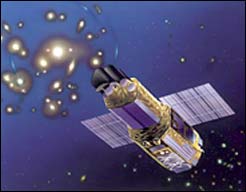

File size : 5.4MB
Format : MPEG
|
 |
Q.4 Since the invention of the modulation collimator, Japan's X-ray astronomy has continued to develop. What do you expect to see in the future?
The passion of the pioneering Dr. Oda has been passed on to those who came after him. Prof. Yasuo Tanaka designed some satellites and discovered broad iron K-lines from the core of a galaxy. Active galactic nuclei are believed to be black holes, which suck materials into them. X-rays are emitted during the process, and when the materials contain iron, X-rays are released from the iron atoms. Broad iron K-lines are X-rays that look broadened or stretched by the effects of the strong gravity of black holes.
In addition, Japan's astronomical observation satellite program, started with HAKUCHO, launched by a team headed by Dr. Oda, followed by TENMA and GINGA, was then followed by ASUCA, with which X-rays from iron atoms, which I pointed out earlier, were discovered. This was a very significant discovery, and I am hoping Japan will continue to achieve such results. The X-ray observation capabilities of ASTRO-EII, which is scheduled to be launched in 2005, are drawing attention from scientists around the world.
 |


The Japanese X-ray observatory satellite and ASTRO-EII illustration |
|
|
I think Japan's astronomy played a big role, especially in the 1980's and 90's. This is because, from Einstein to Chandra, the United States could not maintain its world-leading satellites for twenty years. It seems that Japan and Europe developed their X-ray astronomy during this time. And as a matter of course, we would like to see Japan continue to make great strides. I know Japan is committed to continued research in the field of X-ray astronomy.
Also, in Japan there is a substantial X-ray astronomy research group, and I do hope for their continued success as well. This is one of the very bright aspects of Japanese space research, and I believe that it is the most important contribution Japan can make to science.
As you know, elementary particle physics and X-ray astronomy are currently interacting in the field of supernova observation, for which Dr. Koshiba and I won the Nobel Prize; Dr. Koshiba using neutrinos and myself using X-rays, to discover celestial phenomena.
I have a strong hope that Japan's X-ray astronomy research group will maintain its high level. Otherwise, it would be a big loss for Japan.
[Interviewed on February 27, 2004]
|



